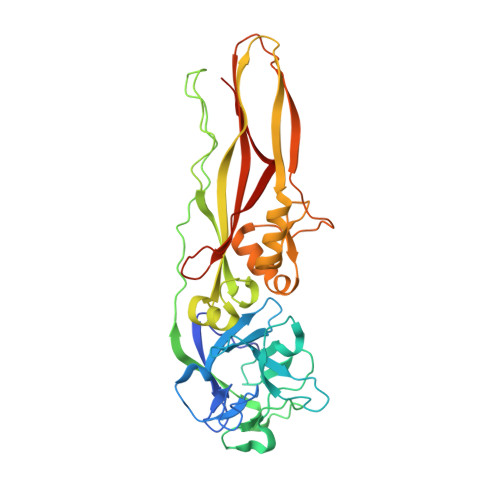The crystal structure of Cry78Aa from Bacillus thuringiensis provides insights into its insecticidal activity.
Cao, B., Nie, Y., Guan, Z., Chen, C., Wang, N., Wang, Z., Shu, C., Zhang, J., Zhang, D.(2022) Commun Biol 5: 801-801
- PubMed: 35945427
- DOI: https://doi.org/10.1038/s42003-022-03754-6
- Primary Citation of Related Structures:
7Y78, 7Y79 - PubMed Abstract:
Genetically modified plants with insecticidal proteins from Bacillus thuringiensis (Bt) have been successfully utilized to control various kinds of pests in crop production and reduce the abuse of pesticides. However, a limited number of genes are available for the protection of crops from rice planthopper. Recently, Cry78Aa protein from Bt strain C9F1 has been found to have high insecticidal activity against Laodelphax striatellus and Nilaparvata lugens. It is the first reported single-component protein in the world to combat rice planthoppers, making it very promising for use in transgenic crops. The ambiguous mechanism of Cry78Aa functions prevented further engineering or application. Here, we report the crystal structure of Cry78Aa, which consists of two domains: a C-terminal β-pore forming domain belonging to the aerolysin family and an N-terminal trefoil domain resembling the S-type ricin B lectin. Thus, Cry78Aa could represent a distinctive type of β-pore forming toxin. We also found that Cry78Aa binds carbohydrates such as galactose derivatives and is essential for insecticidal activity against Laodelphax striatellus. Our results suggest a mechanism underlying the function of Cry78Aa against rice planthoppers and pave the way to maximizing the usage of the toxin.
Organizational Affiliation:
State Key Laboratory for Biology of Plant Diseases and Insect Pests, Institute of Plant Protection, Chinese Academy of Agricultural Sciences, Beijing, 100193, China.
















